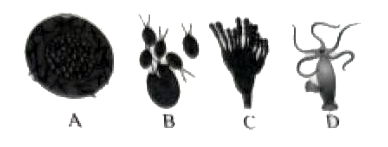Gemmule formation in sponges are useful in
(A) asexual reproduction
(B) sexual reproduction
(C) parthenogenesis
(D) parthenocarpySolution in Gujrati
asexual reproduction
sexual reproduction
parthenogenesis
parthenocarpy
The correct Answer is:A
Step by step video, text & image solution for Gemmule formation in sponges are useful in (A) asexual reproduction (B) sexual reproduction (C) parthenogenesis (D) parthenocarpy by Biology experts to help you in doubts & scoring excellent marks in Class 12 exams.
Updated on:21/07/2023Topper's Solved these Questions
- REPRODUCTION IN ORGANISMSBOOK - KUMAR PRAKASHANCHAPTER - REPRODUCTION IN ORGANISMSEXERCISE - SECTION - E SOLUTION OF NCERT EXEMPLAR (Long Answer Type Questions)
5 Videos
- PRINCIPLES OF INHERITANCE AND VARIATION BOOK - KUMAR PRAKASHANCHAPTER - PRINCIPLES OF INHERITANCE AND VARIATION EXERCISE - SECTION -F (MULTIPLE CHOICE QUESTIONS (MCQS)) (MCQs ASKED IN COMPETITIVE EXAM)
38 Videos
- REPRODUCTIVE HEALTH BOOK - KUMAR PRAKASHANCHAPTER - REPRODUCTIVE HEALTH EXERCISE - Section - F Multiple Choice Questions (MCQs)
102 Videos
Similar Questions
Enumerate the differences between asexual and sexual reproduction. Describe the types of asexual reproduction exhibited by unicellular organisms.
View SolutionThe incorrect statement with regard to haemophilia is
View SolutionWhich problems arise due to uncontrolled population growth ?
View SolutionAsexual reproduction through formation of gemmule occurs in
View SolutionSponges have divison of labour, which cells are found in gemmules for asexual reproduction?
View SolutionGemmule is the asexual reproductive structure of
View SolutionMention the asexual reproduction in (a) Protista, (b) Sponges, (c) Paramoecium , (d) Chalamydomonas.
View SolutionThe gemmule formation is the form of asexual reproduction in class of porifera
View SolutionThe phenomenon wherein, the ovary develops into a fruit without fertilisation is called (A) Parthenocarpy (B) Apomixis (C) Asexual reproduction (D) Sexual reproduction
View SolutionSponges have divison of labour, which cells are found in gemmules for asexual reproduction?
View SolutionGeneral Reproduction in Animals || Asexual and Sexual Reproduction || Parthenogenesis and its types || Human Reproduction Stages
View SolutionDifferentiate between:
Sexual reproduction and Asexual reproduction.
View SolutionAsexual reproduction in sponges occurs by (a) Parthenogenesis (b) Budding (c) Fragmentation (d) Spore
View SolutionStudy the following figures select the correct statement regarding these?
(A) A shows mode of asexual reproduction in sponges through gemmules
(B) B shows sexual reproduction through zoospores in chlamydomonas.
( C ) C shows asexual reproduction through conidiospores in Penicillium
(iv )D shows external budding in Hydra

View Solution
